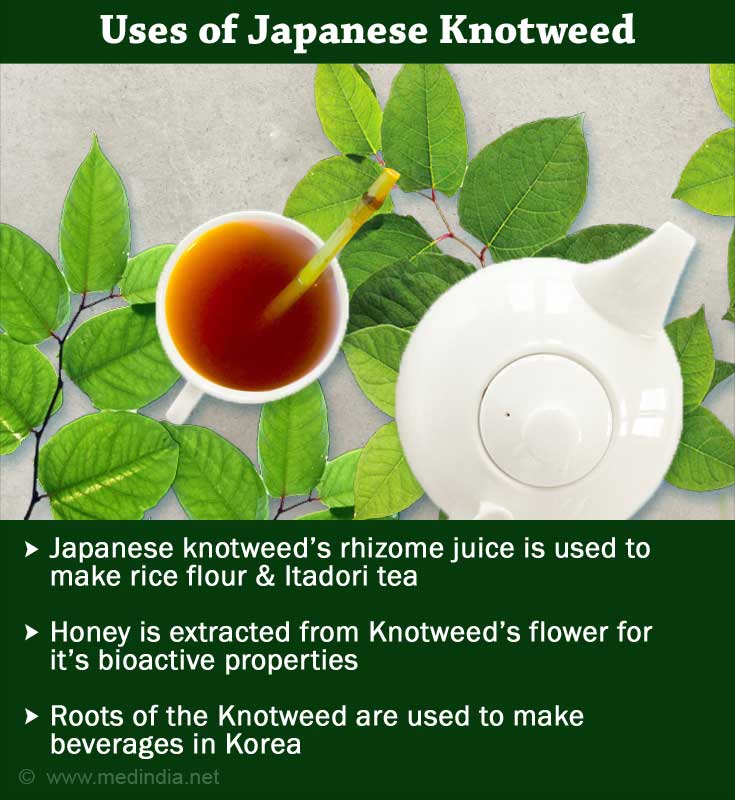- Lachowicz, S., & Oszmiański, J. (2019). Profile of Bioactive Compounds in theMorphological Parts of Wild Fallopia japonica (Houtt) and Fallopia sachalinensis (F.Schmidt) and Their Antioxidative Activity.Molecules (Basel, Switzerland), 24(7), 1436. - (https://doi.org/10.3390/molecules24071436)
- Otilia BOBIS, Daniel Severus DEZMIREAN, Victorița BONTA, Adela MOISE, ClaudiaPASCA, Timea Erzsebet DOMOKOS, Adriana Cristina URCAN. JAPANESE KNOTWEED(FALLOPIA JAPONICA): LANDSCAPE INVASIVE PLANT VERSUS HIGH QUALITYHONEY SOURCE. Scientific Papers. Series D. Animal Science. Vol. LXII, No. 1, 2019. - (http://animalsciencejournal.usamv.ro/pdf/2019/issue_1/Art34.pdf)
- MetliÄar, V., Vovk, I., & Albreht, A. (2019). Japanese and Bohemian Knotweeds asSustainable Sources of Carotenoids. Plants (Basel, Switzerland), 8(10), 384. - (https://doi.org/10.3390/plants8100384)
- Invasive Knotwed Species as a Rich Source of Antioxidants - (https://www.cabi.org/ISC/FullTextPDF/2018/20183332869.pdf)
- Japanese knotweed extract (Polygonum cuspidatum) Resveratrol 98% - (https://newdrugapprovals.org/2014/08/05/japanese-knotweed-extract-polygonum-cuspidatum-resveratrol-98/)
- Medical Attributes of Polygonum cuspidatum - Japanese knotweed - (https://klemow.wilkes.edu/Polygonum09.html)
What is Japanese Knotweed?
Japanese knotweed (Fallopia japonica) is a shrub that grows up to a height of 3m. This perennial herb has rhizomes that are long branched, multiple stems that are erect, and big leaves with elliptical blades. White-yellowish, mono sexual flowers bloom during late summer in the axils of the leaves.
The plant is considered by ISSG (Invasive Species Specialist Group) as one among the “100 World’s Worst Invasive Alien Species.” The plant is known to deliver negative impacts on climate change, animals, genetic diversity, and is also difficult to manage. The roots of the plant may cause damage to buildings, concrete foundations, paving, and roads. However, the plant also displays valuable sides of itself.
The plant’s flowers are sources of nectar that is used in honey production. The leaves and stems of the plant can also accumulate heavy metals present in contaminated soil and the roots of the plant enchant several health benefits. The paper industry makes use of its biomass as raw materials.
In traditional medicine, the plant is used to treat altered lipid profiles, infections, cancer, toothache, hemorrhoids, ulcer, digestive problems, and many more.
What are the Health Benefits of Japanese Knotweed?

Regardless of its potential negative impacts, studies on its active components and health benefits have turn around the world’s perspective towards the plant.
The plant exhibits antioxidant, anticancer, anti-inflammatory, antitumor, nerve protecting properties and many more. It may also help in weight loss and prevent and manage diabetes.
Antioxidant Activity: The extracts of this perennial herb are rich in antioxidants, mainly resveratrol. It has shown great benefits in aging, life span, and skin health. The resveratrol extracted from its roots is used as a dietary supplement for several health conditions, in medicine, and beauty products. Other antioxidant metabolites include quinines, stilbenes, flavonoids, catechols, phenolic acids, and tannins.
Weight Loss: The appreciable amount of resveratrol in the plant may help with weight loss, when its supplementation is coupled with physical activity and the right diet. Its mechanism for weight loss owes to its ability to boost metabolism and regulate estrogen levels. Boosting of metabolism augments processing of food consumed and hampers body fat storage, and regulating estrogen levels will help build muscles.
Antimicrobial Activity: Extracts of Japanese knotweed leaves found to contain components such as epicatechin, quercetin, and rutin that exhibit antimicrobial properties. Epicatechin is studied to impede the growth of Gram-positive bacteria but presented much lesser antifungal activity.
Cardiovascular Benefits: The resveratrol content of the herb may possess anticoagulant properties by reducing blood viscosity. It may also help in treating heart diseases like myocardial infarctions by preventing blood clots and embolisms. Resveratrol can also be beneficial in aspirin resistance by down-turning platelet aggregation.
Phytoestrogen Activity: Phytoestrogens are foods that produce similar effects of the hormone estrogen when ingested in the body. The resveratrol present in the plant acts as anagonist to receptors of estrogen and inhibits estradiol. It also aids in muscle building by regulating estrogen levels.
Lipid-Lowering Effects: Animal studies reported that bioactive components, namely polydatin and emodin aid in lowering lipid levels and may also have liver-protective effects.
Recipes
Apart from its therapeutic uses, the culinary uses of the plant are several. The young shoots of the plant that is grown up to 20cm height are used similar to asparagus and it has a sour taste. The plant is also used as a replacement for rhubarb in dishes.

The juice of its rhizome is used in the making of rice flour and to make “Itadori” Tea (meaning “well-being‟ in Japanese). On account of its rich resveratrol content, the tea can be used to replace red wine. In India and South Asia, the knotweed is replaced by tapioca.
Honey from Japanese knotweed is widely famous. Honey is derived from the knotweed’s flowers and is also studied for its bioactive properties and chemical composition. Its honey has characteristics parallel to buckwheat honey. The roots of the plant are used to make beverages in Korea. Other culinary uses include the preparation of salads and soups.
Nutritional Facts of Japanese Knotweed
Different parts of the plant contain several bioactive components namely resveratrol, polyphenols, tannins, anthraquinones, carotenoids, sterols, proanthocyanidins, emodin, and many more.
Japanese knotweed is also a good source of vitamin C, manganese, and zinc. The carotenoid content in the green leaves of the knotweed is 378mg/100g dry weight.
Honey from the plant is found to be high in potassium (1187 to 6196 mg/kg) and sodium (58.8 to 68.8 mg/kg). Total polyphenols and flavonoids are also present in high amounts.
The toxicity of the plant is not much studied. However, concerns towards consuming the plant are for pregnant women, and people at risk for arthritis, gout, and kidney stones due to its oxalic acid content.
In concern to the threats, the plant possesses towards natural habitats and the environment, keeping them under observation can be valuable.
Regardless of its invasiveness, the plant is finding its way in the field of health, nutrition, nutraceuticals, therapeutics, and cosmetics for its salubrious effects and is being shone a light by researchers for the same recently.






